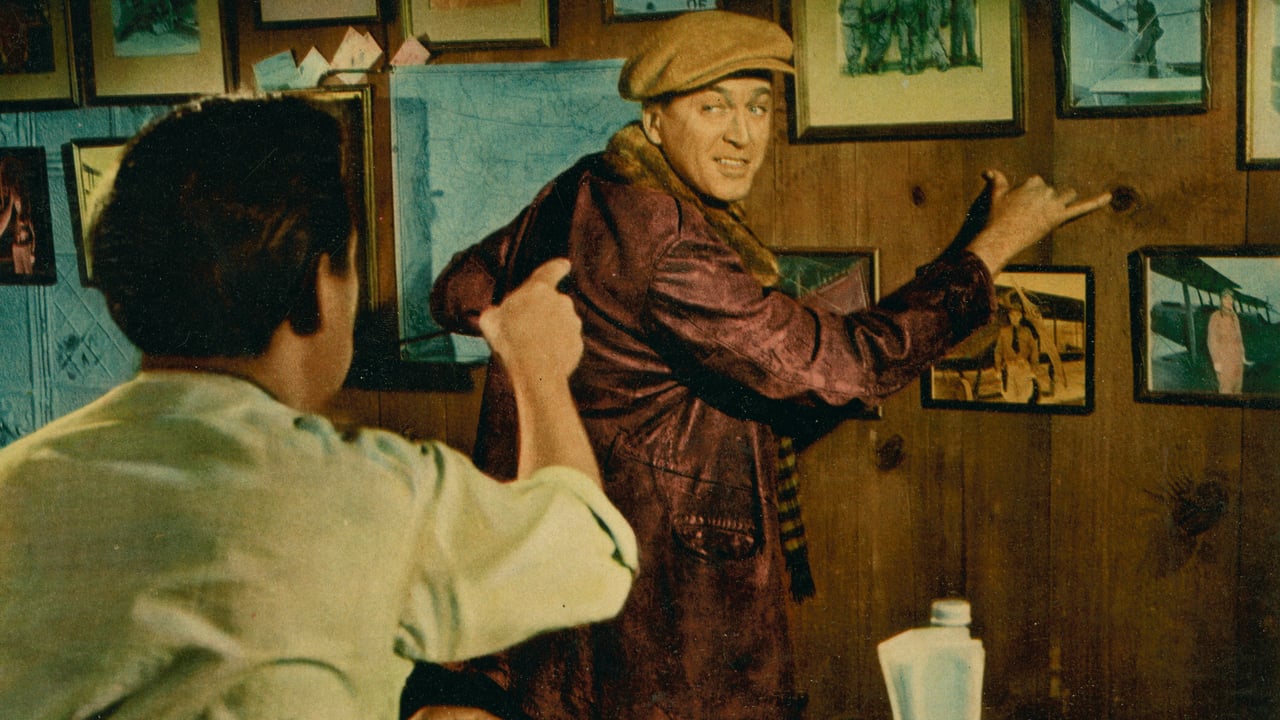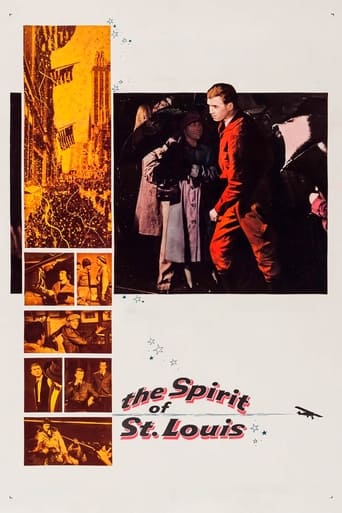

A Leland Hayward/Billy Wilder Production. Copyright 1957 by Warner Bros Pictures. New York opening at the Radio City Music Hall: 21 February 1957. U.S. release: 20 April 1957. U.K. release: 11 August 1957. Australian release: 31 October 1957. 12,138 feet. 134 dreary minutes.SYNOPSIS: The story is Charles A. Lindbergh's solo flight across the Atlantic Ocean in 1927. As an airmail pilot Lindbergh (Stewart) becomes aware of the possibility of a successful journey across the Atlantic. He struggles to find backers for his project. He finally gets a group of St Louis business men to promote the trip and a single-engine monoplane is built and then named by the backers, "The Spirit of St Louis". NOTES: Negative cost: $6 million. Initial worldwide rentals gross: just over $4 million. Almost all of this money was earned in the domestic market, making it one of the top 25 box-office attractions in the U.S.A./Canada for 1957. The film lost at least $2 million dollars world-wide when you include advertising and release costs.Louis Lichtenfield was nominated for an Academy Award for his Visual Effects, losing to the only other nominee, The Enemy Below.Filmed on location at Santa Monica Airport, Long Island, Manhattan, Guyancourt, near Versailles, and (aerial scenes) along the Great Circle flight-line, August 1955-March 1956.VIEWERS' GUIDE: A sure-fire deterrent for kids who might be tempted to misbehave. "Johnny, you start just one more fight with little Virgil and I'll make you watch The Spirit of St Louis all the way through."COMMENT: It's a sad but inevitable fact of life that yesterday's super-heroes are today's forgotten men and women. Idols usually do not span generations. There are many reasons for this, but I guess the principal ones are that the new generation is naturally suspicious of the values of the old and - at the other end of the scale - that historical accomplishments have no elements of suspense. We know Lindy is going to successfully overcome all sorts of obstacles to get his plane ready and then accomplish the mission. So I'm not surprised the picture failed at the box-office. I'm not saddened either, because in a way it deserved its fate. The picture is made in a very craftsmanlike fashion - and on a spectacular budget too - but for the most part it's very stolidly and unimaginatively put together. The take-off sequence is inventively and suspensefully cut, but why wasn't the whole film? It could have come in at a third the length and given us as much information, but three times the thrillsWhile Wilder is to be commended for not throwing in a spurious love interest, the net result is to focus all the film's attention on James Stewart. If you're a Stewart fan, fine. He's in just about every frame. All the other players have miniscule roles.Director Wilder fans, however, are advised to avoid this plodding Spirit. There is precious little wit and no incisive social comment here.OTHER VIEWS: With eight box-office hits in a row behind him, it seemed unlikely that-James Stewart would give Warner Brothers what Jack L. Warner a few years later called "the most disastrous failure we ever had". - Allen Eyles in James Stewart.
... View MoreDirected by the great Billy Wilder (surprisingly), and based on the book by Charles Lindbergh which was adapted by Charles Lederer (the director wrote the screenplay with Wendell Mayes), this slightly above average if overlong biographical drama tells the story of the man who would one day become the first to fly non-stop from New York to Paris in 1927. This historic first transatlantic flight helped to create the airline industry.James Stewart (again, surprisingly; he was nearly 40, but portraying a man 25 years old) plays this man, Charles Augustus 'Slim' Lindbergh, whose plane (designed and built by Ryan Aircraft in San Diego, California) was dubbed "The Spirit of St. Louis (1957)", for the businessmen from that city that helped to fund the effort. The story tells about Lindbergh's early life as a brave mail carrying pilot in the early days of aviation (though there's no real drama about whether he survived in the fog).But much of the film's 'action' involves the history making flight itself, with actor Stewart's voice providing narration for his character's thoughts, while he tries to stay awake during the 30+ hour journey.This movie received an Academy Award nomination for its Special Effects, representing the only Oscar nomination for Louis Lichtenfield. Murray Hamilton, Patricia Smith, Bartlett Robinson, Marc Connelly, Arthur Space, and Charles Watts play the other, minor, credited roles.
... View MoreCharles Lindbergh's historic, epic solo trans-Atlantic flight in 1927, the first ever solo crossing of the Atlantic in an airplane. We see how Lindbergh set about organising financiers for his flight, purchasing, designing and building the plane, test flights, (through news on other fliers) the potential fates awaiting him and the flight itself, especially the hardships he had to endure and how he overcame them. We also see, though flashbacks, his earlier life - how he learnt to fly and his first few jobs in aviation.Despite being directed by master-director Billy Wilder and starring the great James Stewart, I did not have high hopes for this movie. It seemed like a fairly dry subject and could easily have degenerated into a paint-by-numbers historical drama. However, Wilder makes it interesting, through the flashbacks and, especially, hearing Lindbergh's thoughts. The thoughts show the genius of the man - how he approached problems, his endurance and his resourcefulness. Wilder does a good job at showing the hardships Lindbergh had to go through and how easily he could have failed. Shows well just what an heroic feat it was. Good work from Jimmy Stewart as Lindbergh. At the time he was about 23 years older than his character but it doesn't really show. Interesting, entertaining dramatisation of a very historic event.
... View MoreCharles "Slim" Lindbergh (James Stewart) struggles to finance and design an airplane that will make his New York to Paris flight the first solo transatlantic crossing.Much has been made of James Stewart being miscast for the role of Charles Lindbergh. Indeed, his hair looks funny, he does not generally look like Lindbergh, and there was a 22 year age gap that simply is not able to cover up. And I, too, have my reservations about this casting. But I think in retrospect (fifty years later), it played out well, as James Stewart is iconic and brings something to the film other actors (such as Anthony Perkins) probably would not for modern audiences.And the real beauty is that today people know that Lindbergh crossed the Atlantic (if they know him at all), but they know little else about the man or the journey. Looking past the casting issues, the film is great for making the story accessible to audiences that have little interest in reading or history. (Which is unfortunate, but in many cases true.)
... View More